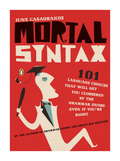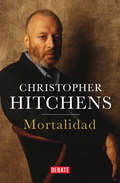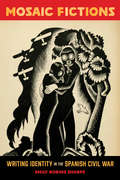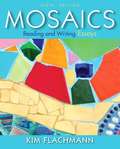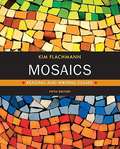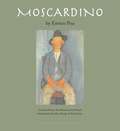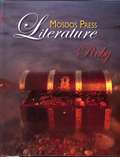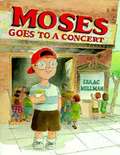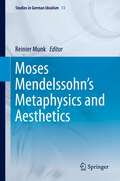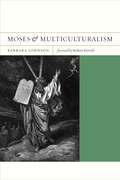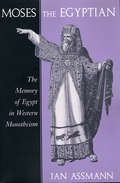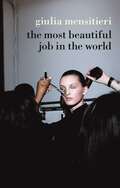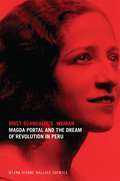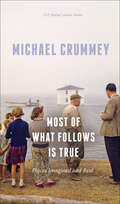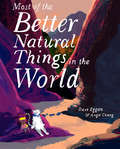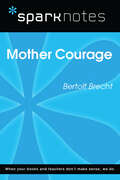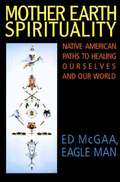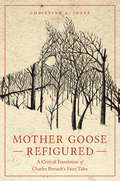- Table View
- List View
Morson's English Guide for Court Reporters (2nd Edition)
by Lillian I. MorsonThis guide presents the fundamental rules for punctuating acceptable syntax and then goes a step further and presents verbatim English as found in courtroom transcripts and modifies the rules to accommodate this English. The grammar section and glossary offer a look at the way we name and define the elements in a sentence so that we can better understand standard word usage, spelling, and punctuation.
Mortal Syntax
by June CasagrandeThe only fun, friendly, and surefire defense against the grammar snobs Having already made a name for herself with Grammar Snobs Are Great Big Meanies, now in its fifth printing, June Casagrande returns with Mortal Syntax, taking on the 101 most frequently attacked usage choices. Dedicating one short chapter to each, Casagrande brings her subject to life, teaching English usage through lively and amusing personal anecdotes. Mortal Syntax includes such chapters as: ? "I wish I was taller" ? "I am continuously watching Simpsons reruns" ? "Was it Horton that heard the Who?" Casagrande's clear and concise lessons-with entertaining titles and themes-make a potentially prickly subject go down like a spoonful of sugar. .
Mortalidad
by Christopher HitchensMortalidad es la historia ejemplar de la resistencia de un hombre a retroceder al enfrentarse a lo desconocido, así como una penetrante mirada a la condición humana. El 8 de junio de 2010, durante la gira de promoción de su libro de memorias, Hitch-22, un insoportable dolor en el pecho y el tórax dejó postrado a Christopher Hitchens en su habitación de hotel en Nueva York. Como escribiría más tarde en una de sus premiadas columnas en Vanity Fair, se vio deportado de repente «del país de los sanos al otro lado de la dura frontera que rodea la tierra de la enfermedad». A lo largo de los siguientes dieciocho meses, hasta su muerte en Houston el 15 de diciembre de 2011, siguió escribiendo con la misma frecuencia y brillantez que siempre, asombrando a sus lectores con su capacidad de trabajo en las peores condiciones. Durante su enfermedad, un cáncer de esófago, Hitchens rechazó insistente y gallardamente el consuelo de la religión, y prefirió enfrentarse a la muerte mirándola de frente. En este emocionante relato de esos meses, Hitchens describe los tormentos de la enfermedad, discute sus tabúes y analiza cómo transforma la experiencia humana y cambia la relación del enfermo con el mundo que le rodea. Intenso y poderoso, atravesado de su característica inteligencia, el testamento de Hitchens es una obra literaria valiente y lúcida, una afirmación de la dignidad y el valor del ser humano. «En mis tiempos, me he despertado más de una vez sintiendo que me moría. Pero nada me había preparado para la mañana de junio en la que, al recobrar la conciencia, me sentí como si de verdad estuviera encadenado a mi propio cadáver. Toda la cavidad de mi pecho y mi tórax parecía haberse vaciado y después llenado con cemento de secado lento. Me oía respirar débilmente, pero no podía inflar los pulmones. Mi corazón latía demasiado o demasiado poco. Cualquier movimiento, por pequeño que fuera, requería premeditación y planificación. Me exigió un esfuerzo extenuante cruzar la habitación de mi hotel de Nueva York y llamar a los servicios de urgencias. Llegaron con gran rapidez y se comportaron con inmensa cortesía y profesionalidad. Tuve tiempo de preguntarme para qué necesitaban tantas botas y cascos y tanto pesado equipamiento de apoyo, pero ahora que visualizo la escena retrospectivamente la veo como una deportación muy amable y firme, que me llevó desde el país de los sanos a la frontera inhóspita del territorio de la enfermedad. En unas horas, tras realizar una buena cantidad de trabajo en mi corazón y mis pulmones, los médicos de ese triste puesto fronterizo me habían enseñado unas cuantas postales del interior, y me habían dicho que mi siguiente e inmediata parada tendría que ser con un oncólogo. Alguna clase de sombra se proyectaba en los negativos.»Christopher Hitchens
Mortality and Form in Late Modernist Literature
by John Whittier-FergusonThis wide-ranging study of the late poetry and prose of Virginia Woolf, T. S. Eliot, Gertrude Stein, and Wyndham Lewis brings together works from the 1930s and 1940s - writings composed by authors self-consciously entering middle to old age and living through years when civilization seemed intent on tearing itself to pieces for the second time in their adult lives. Profoundly revising their earlier work, these artists asked how their writing might prove significant in a time that Woolf described, in a diary entry from 1938, as '1914 but without even the illusion of 1914. All slipping consciously into a pit'. This late modern writing explores mortality, the frailties of culture, and the potential consolations and culpabilities of aesthetic form. Such writing is at times horrifying and objectionable and at others deeply moving, different from the earlier works which first won these writers their fame.
Mosaic Fictions: Writing Identity in the Spanish Civil War
by Emily Robins SharpeMosaic Fictions is the first book-length critical analysis of Canadian Spanish Civil War literature. Treating published and archival writings, the book focuses on the extensive contributions of Jewish Canadian authors as they articulate the stakes of the Spanish Civil War (1936–39) in the language of a nascent North American multiculturalism. Placing Jewish Canadian writers within overlapping North American networks of Jewish, Black, immigrant, female, and queer writers challenges the national distinctions that dominate current critical approaches to Anglophone Spanish Civil War literature. Reframing the narrative of Spain’s noble but tragic struggle against fascism in the Spanish Civil War, the book demonstrates how marginalized North American supporters of the Spanish Republic crafted narratives of inclusive citizenship amidst a national crisis not entirely their own. Mosaic Fictions examines texts composed between the war’s outbreak and the present to illuminate the integral connections between Canada’s developing national identity and global leftist action.
Mosaics: Reading And Writing Essays (Sixth Edition)
by Kim FlachmannMosaics illustrates how reading and writing are part of a interrelated process, and encourages students to discover how the "mosaics" of their own reading and writing processes work together to form a coherent whole.
Mosaics: Reading and Writing Essays (5th Edition)
by Kim FlachmannMosaics illustrates how reading and writing are part of an interrelated process, and encourages students to discover how the "mosaics" of their own reading and writing processes work together to form a coherent whole.
Moscardino
by Ezra Pound Enrico PeaA small masterpiece, Pea's lyrical autobiographical novel paints a fiery and intimate portrait of an old man through the bold brushstrokes of his grandson. The passions and tensions between the old eccentric and his brothers play themselves out in mythical sketches before a vivid backdrop of the hills of Lunigiana. Moscardino, the first novella of his tetralogy, Il romanzo di Moscardino, is anarchic and haunting. Pound conducts Pea's vernacular song, allowing images to flow from the land, the flesh, and beyond.
Mosdos Literature Series: Pearl
by Judith FactorSelections of fiction, poetry and other writing help you to be a strong reader.
Mosdos Press Grade 5 Coral Student Activity Workbook
by Judith Factor Mosdos LiteratureThis Mosdos Press Grade 5 Coral Student Activity Workbook includes six workbook pages that correspond to each section taught in the Coral Text (not-included). Each unit includes two vocabulary exercises plus comprehension questions that include "in-depth thinking" and "drawing conclusions" questions and an essay activity entitled "one-step further." Finally, a two-page graphic organizer emphasizes the main idea and important language arts skill, and gives the student the chance to think about their reading visually.
Mosdos Press Literature: Gold (Book Two)
by Mosdos Press StaffIn this book, students will be intrigued by introductory word banks with fascinating bits of information, and helped by vocabulary definitions on each page. The students will have a joy of reading Short Stories, Novella, Poetry, Drama, Nonfiction Essays, Complete Novel, etc.
Moses Goes to a Concert
by Isaac Millman"Moses and his school friends are deaf, but like most children, they have a lot to say. They communicate in American Sign Language, using visual signs and facial expressions. This is called signing. And even though they can't hear, they can enjoy many activities through their other senses. Today, Moses and his classmates are going to a concert. Their teacher, Mr. Samuels, has two surprises in store for them, to make this particular concert a special event."
Moses Mendelssohn's Metaphysics and Aesthetics
by Reinier MunkThis book presents an extended dialogue in essay form between specialists in the work of Moses Mendelssohn, and experts in important trends in related late-seventeenth and eighteenth century thought. The first group of contributors explores themes in Mendelssohn's metaphysics and aesthetics, presenting both their internal argumentative coherence and their historical context. The second outlines the context of Mendelssohn's views on specific topics, and describes his contribution to the discussion of them. The essays are organized in four sections. The first pairs two essays on Mendelssohn's theory of language and writing. The second section offers three essays addressing a number of topics in Mathematics and philosophy in Mendelssohn. A group of eight essays follows, dealing with Metaphysics in a historical context. The fourth section presents five essays discussing Mendelssohn's Aesthetics in a historical context. Moses Mendelssohn's Metaphysics and Aesthetics arises from a conference held in Amsterdam in 2009, which gathered numerous authorities to address the central theme. Taken together, these eighteen essays present a sophisticated portrait of Mendelssohn, packed with detail and rich in complexity.
Moses and Multiculturalism
by Barbara JohnsonWeaving together various texts--biblical passages, philosophy, poems, novels, opera, and movies, the book explores how the story of Moses has been appropriated, reimagined, and transmitted across cultures and historical moments.
Moses the Egyptian: The Memory Of Egypt In Western Monotheism
by Jan Assmann"Standing at the very foundation of monotheism, and so of Western culture, Moses is a figure not of history, but of memory. As such, he is the quintessential subject for the innovative historiography Jan Assmann both defines and practices in this work, the study of historical memory—a study, in this case, of the ways in which factual and fictional events and characters are stored in religious beliefs and transformed in their philosophical justification, literary reinterpretation, philological restitution (or falsification), and psychoanalytic demystification. To account for the complexities of the foundational event through which monotheism was established, Moses the Egyptian goes back to the short-lived monotheistic revolution of the Egyptian king Akhenaten (1360–1340 B.C.E.). Assmann traces the monotheism of Moses to this source, then shows how his followers denied the Egyptians any part in the origin of their beliefs and condemned them as polytheistic idolaters. Thus began the cycle in which every “counter-religion,” by establishing itself as truth, denounced all others as false. Assmann reconstructs this cycle as a pattern of historical abuse, and tracks its permutations from ancient sources, including the Bible, through Renaissance debates over the basis of religion to Sigmund Freud’s Moses and Monotheism. One of the great Egyptologists of our time, and an exceptional scholar of history and literature, Assmann is uniquely equipped for this undertaking—an exemplary case study of the vicissitudes of historical memory that is also a compelling lesson in the fluidity of cultural identity and beliefs."
Most Beautiful Job in the World
by Giulia MensitieriFashion is one of the most powerful industries in the world, accounting for 6 per cent of global consumption and growing steadily. Since the 1980s and the birth of the neoliberal economy, it has emerged as the glittering face of capitalism, bringing together prestige, power and beauty and occupying a central place in media and consumer fantasies. Yet the fashion industry, which claims to offer highly desirable job opportunities, relies significantly on job instability, not just in outsourced garment production but at the very heart of its creative production of luxury. Based on an in-depth investigation involving stylists, models, designers, hairdressers, make-up artists, photographers and interns, anthropologist Giulia Mensitieri draws back fashion's glamorous facade to explore the lived realities of working in the industry. This challenging book lays bare the working conditions of 'the most beautiful job in the world', showing that exploitation isn't confined to sweatshops or sexual harassment of models, but exists at the very heart of the powerful symbolic and economic centre of fashion.
Most Scandalous Woman: Magda Portal and the Dream of Revolution in Peru
by Myrna Ivonne Wallace FuentesIn 1926 a young Peruvian woman picked up a gun, wrested her infant daughter from her husband, and liberated herself from the constraints of a patriarchal society. Magda Portal, a poet and journalist, would become one of Latin America’s most successful and controversial politicians. In this richly nuanced portrayal of Portal, historian Myrna Ivonne Wallace Fuentes chronicles the dramatic rise and fall of this prominent twentieth-century revolutionary within the broader history of leftist movements, gender politics, and literary modernism in Latin America. <p><p> An early member of bohemian circles in Lima, La Paz, and Mexico City, Portal distinguished herself as the sole female founder of the American Popular Revolutionary Alliance (APRA). A leftist but non-Communist movement, APRA would dominate Peru’s politics for five decades. Through close analysis of primary sources, including Portal’s own poetry, correspondence, and other writings, Most Scandalous Woman illuminates Portal’s pivotal work in creating and leading APRA during its first twenty years, as well as her efforts to mobilize women as active participants in political and social change. Despite her successes, Portal broke with APRA in 1950 under bitter circumstances. Wallace Fuentes analyzes how sexism in politics interfered with Portal’s political ambitions, explores her relationships with family members and male peers, and discusses the ramifications of her scandalous love life. <p> In charting the complex trajectory of Portal’s life and career, Most Scandalous Woman reveals what moves people to become revolutionaries, and the gendered limitations of their revolutionary alliances, in an engrossing narrative that brings to life Latin American revolutionary politics.
Most Useful Verbs and Word Formation
by Prof. Yashwant VyasEasy English course with grammar to learn English very easily.
Most of What Follows is True: Places Imagined and Real (The CLC Kreisel Lecture Series)
by Michael CrummeyThe prizewinning author of The Innocents examines the relationships among fact, fiction, fictionalization, and appropriation in this thought-provoking work.“In all creative writing, the question of what is true and what is real are two very different considerations. Figuring out how to dance between them is a murky business.”In Most of What Follows Is True, Michael Crummey examines the complex relationship between fact and fiction, between the “real world” and the stories we tell to explain it. Drawing on his own experience appropriating historical characters to fictional ends, he brings forward important questions about how writers use history and real-life figures to animate fictional stories. Is there a limit to the liberties a writer can take? Is there a point at which a fictionalized history becomes a false history? What responsibilities do writers have to their readers, and to the historical and cultural materials they exploit as sources? Crummey offers thoughtful, witty views on the deep and timely conversation around appropriation.
Most of the Better Natural Things in the World
by Dave EggersA tiger carries a dining room chair on her back. But why? Where is she going? With just one word per page, in lush, color-rich landscapes, we learn about the features that make up our world: an archipelago, a dune, an isthmus, a lagoon. Across them all, the tiger roams. This enigmatic investigation of our world's most beautiful places from bestselling author Dave Eggers is beautifully illustrated by debut artist Angel Chang.
Mother Courage (SparkNotes Literature Guide Series)
by SparkNotesMother Courage (SparkNotes Literature Guide) by Bertolt Brecht Making the reading experience fun! Created by Harvard students for students everywhere, SparkNotes is a new breed of study guide: smarter, better, faster. Geared to what today's students need to know, SparkNotes provides: *Chapter-by-chapter analysis *Explanations of key themes, motifs, and symbols *A review quiz and essay topicsLively and accessible, these guides are perfect for late-night studying and writing papers
Mother Earth Spirituality: Native American Paths to Healing Ourselves
by Ed McGaa"A dear stream of practical knowledge with the mind change we need to save the life of our Mother Earth--and ourselves . . . This is a book for every person who loves this planet. Eagle Man shows us the joyful path home to our universal Mother."?ynthia Bend, Water Spirit Woman, co-author of Birth of a Modem Shaman"A rich panorama of our native heritage which allows the seeker access to the heart of the Path of Beauty. Ed McGaa has walked this path so that all people may live in harmony."Samie Sams, Hancoka Olowanpi, author of Midnight Song: Quest for the Vanished Ones"Ed McGaa is one of the first persons who can write about 0glala religion in the first person because he has lived it. For years anthropologists have hoped a Native American would portray that society from the inside out. Ed McGaa has. It's about time."William K. Powers, author of 0glala Religion"Fascinating as well as inspiring reading. Ed McGaa makes an excellent spiritual guide and intellectual teacher . . . The information stimulates the mind, the drawings delight the eye, and the ideas soothe the spirit."Jack Weatherford, author of Indian Givers"Profound and insightful . . . Mother Earth Spirituality will be of great importance to those of us, both 'rainbow' and non-Indian people, who walk over land in search of a deeper spiritual life . . . For us, this book is an invaluable guide showing us how to do it."Fred Alm Wolf, Ph.D., author of Taking the Quantum Leap
Mother Goose Refigured: A Critical Translation of Charles Perrault’s Fairy Tales (Series in Fairy-Tale Studies)
by Christine A. JonesCharles Perrault published Histoires ou Contes du temps passé (“Stories or Tales of the Past”) in France in 1697 during what scholars call the first “vogue” of tales produced by learned French writers. The genre that we now know so well was new and an uncommon kind of literature in the epic world of Louis XIV’s court. This inaugural collection of French fairy tales features characters like Sleeping Beauty, Cinderella, and Puss in Boots that over the course of the eighteenth century became icons of social history in France and abroad. Translating the original Histoires ou Contes means grappling not only with the strangeness of seventeenth-century French but also with the ubiquity and familiarity of plots and heroines in their famous English personae. From its very first translation in 1729, Histoires ou Contes has depended heavily on its English translations for the genesis of character names and enduring recognition. This dependability makes new, innovative translation challenging. For example, can Perrault’s invented name “Cendrillon” be retranslated into anything other than “Cinderella”? And what would happen to our understanding of the tale if it were? Is it possible to sidestep the Anglophone tradition and view the seventeenth-century French anew? Why not leave Cinderella alone, as she is deeply ingrained in cultural lore and beloved the way she is? Such questions inspired the translations of these tales in Mother Goose Refigured, which aim to generate new critical interest in heroines and heroes that seem frozen in time. The book offers introductory essays on the history of interpretation and translation, before retranslating each of the Histoires ou Contes with the aim to prove that if Perrault’s is a classical frame of reference, these tales nonetheless exhibit strikingly modern strategies. Designed for scholars, their classrooms, and other adult readers of fairy tales, Mother Goose Refigured promises to inspire new academic interpretations of the Mother Goose tales, particularly among readers who do not have access to the original French and have relied for their critical inquiries on traditional renderings of the tales.

